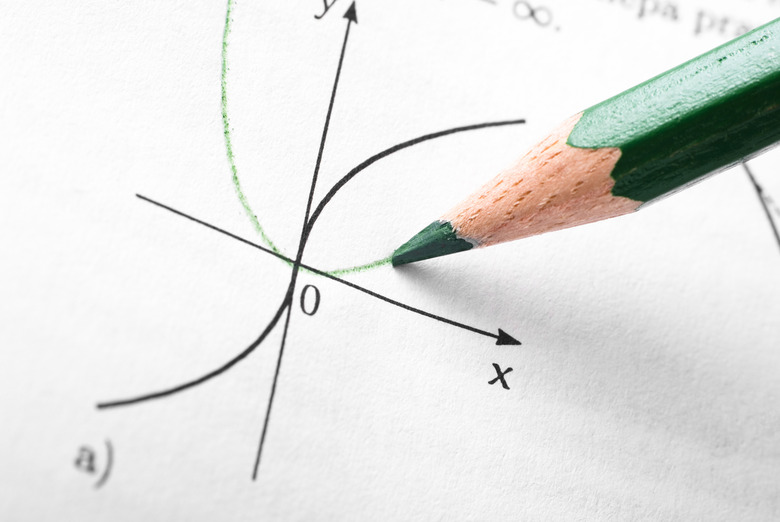Difference Between Proportional & Linear Relationships
Mathematicians, physicists and engineers have many terms to describe mathematical relationships. There is usually some logic to the names chosen, although this is not always apparent if you are not aware of the math behind it. Once you understand the concept involved the connection to the chosen words becomes obvious.
These proportional and linear relationships are two metrics that can help describe a constant rate of change (which in a classic coordinate plane describes the slope of a line).
TL;DR (Too Long; Didn't Read)
The relationship between variables can be linear, non-linear, proportional or non-proportional. A proportional relationship is a special kind of linear relationship, but while all proportional relationships are linear relationships, not all linear relationships are proportional.
Proportional Relationships
Proportional Relationships
If the relationship between x and y is proportional, it means that as x changes, y changes by the same percentage. Therefore, if x grows by 10 percent of x, then y grows by 10 percent of y. To put it algebraically:
\(y = mx\)
where m is a constant. This is a proportional equation where at any single point, the constant of proportionality (m) can be found using the equation y above to solve for m.
Another key distinction between proportionalities are relationships that are directly proportional compared to relationship that are inversely proportional.
- Directly proportional relationships occur with the aforementioned situation where the inputs changes (increasing/decreasing) results in the same response from the output (i.e. if x increases, y increases).
- Inversely proportional relationships are the opposite, where the output counteracts any changes from the input (i.e. if x increases, y decreases. An general formula is below:
\(y = \frac{m}{x}\)
\(\ \newline{}\)
\(\text{ this is equivalent to raising x to the -1 exponent}\)
\(\ \newline{}\)
\(y = mx^{-1}\)
Non-proportional operations
Consider a non-proportional situation. Children look different than adults, even in photographs where there is no way to tell exactly how tall they are, because their proportions are different. Children have shorter limbs and bigger heads compared to their bodies than adults do. Children's features, therefore, grow at disproportionate rates as they become adults.
Tip
If a situation is not proportional, then it may or may not also be non-linear. However, this is not necessarily true in reverse; a relationship can be linear but non-proportional depending on the y-value at x = 0.
Linear Relationship
Linear Relationship
Mathematicians love to graph functions. A linear function is very easy to graph, because it is a straight line. Expressed algebraically, linear functions take the form y = f(x); a function with an input of x:
\(y = mx + b\)
where m is the slope of the line and b is the point where the line crosses the y axis, known as the y-intercept. It is important to note that m or b or both constants can be zero or negative. If m is zero, the function is simply a horizontal line at a distance of b from the x axis. With a linear graph you can almost immediately tell if the function is proportional or strictly linear (think about comparing the graph of y = x with the graph of y = x + 1. While the slope-intercept form is very similar, there would be a visible and significant different between a table of values for each equation and the direct variation between them.
Linear vs Proportional Relationships
Linear vs Proportional Relationships
Proportional and linear functions are almost identical in form. The only difference is the addition of the b constant to the linear function. Indeed, a proportional relationship is just a linear relationship where b = 0, or to put it another way, where the line passes through the origin (0, 0). So a proportional relationship is just a special kind of linear relationship, i.e., all proportional relationships are linear relationships (although not all linear relationships are proportional).
When b ≠ 0, then it is described as a non-proportional linear relationship. This means that there is a linear relation between the independent variable and the dependent variable, but it is not necessarily anchored at the origin. While the variables might increase with a constant ratio the linear equation does not necessarily begin at a value of 0.
Examples of Proportional and Linear Relationships
Examples of Proportional and Linear Relationships
A simple illustration of a proportional relationship is the amount of money you earn at a fixed hourly wage of $10 an hour. At zero hours, you have earned zero dollars, at two hours, you have earned $20 and at five hours you have earned $50. The relationship is linear because you get a straight line if you graph it, and proportional because zero hours equals zero dollars.
Compare this with a linear but non-proportional relationship. For example, the amount of money you earn at $10 an hour in addition to a $100 signing bonus. Before you start working (that is, at zero hours) you have $100. After one hour, you have $110, at two hours $120, and at five hours $150. The relationship still graphs as a straight line (making it linear) but is not proportional because doubling the time you work does not double your money.
Cite This Article
MLA
Kantain, Tom. "Difference Between Proportional & Linear Relationships" sciencing.com, https://www.sciencing.com/difference-between-proportional-linear-relationships-8531541/. 28 March 2023.
APA
Kantain, Tom. (2023, March 28). Difference Between Proportional & Linear Relationships. sciencing.com. Retrieved from https://www.sciencing.com/difference-between-proportional-linear-relationships-8531541/
Chicago
Kantain, Tom. Difference Between Proportional & Linear Relationships last modified March 28, 2023. https://www.sciencing.com/difference-between-proportional-linear-relationships-8531541/
